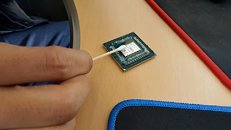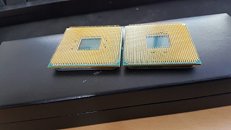- Joined
- Oct 9, 2007
- Messages
- 47,895 (7.38/day)
- Location
- Dublin, Ireland
| System Name | RBMK-1000 |
|---|---|
| Processor | AMD Ryzen 7 5700G |
| Motherboard | Gigabyte B550 AORUS Elite V2 |
| Cooling | DeepCool Gammax L240 V2 |
| Memory | 2x 16GB DDR4-3200 |
| Video Card(s) | Galax RTX 4070 Ti EX |
| Storage | Samsung 990 1TB |
| Display(s) | BenQ 1440p 60 Hz 27-inch |
| Case | Corsair Carbide 100R |
| Audio Device(s) | ASUS SupremeFX S1220A |
| Power Supply | Cooler Master MWE Gold 650W |
| Mouse | ASUS ROG Strix Impact |
| Keyboard | Gamdias Hermes E2 |
| Software | Windows 11 Pro |
Here are some of the first pictures of an AMD socket AM4 APU being de-lidded. De-lidding is the process of removing the IHS (integrated heatspreader), the metal plate covering the CPU die. Some PC enthusiasts remove the IHS to improve heat-transfer between the CPU and extreme cooling solutions, such as LN2/dry-ice evaporators. Overclocker Nam Dae Won, with access to a couple of socket AM4 chips (most likely 7th generation A-series "Bristol Ridge" APUs), de-lidded the chips, revealing a large rectangular die. AMD is using high-quality TIM between the die and the IHS, which could either be solder or liquid metal. There's also a clear picture of the underside pin-grid of the AM4 chip, which has a central cutout that lacks any SMT components. Socket AM4 has 1,331 pins.





View at TechPowerUp Main Site





View at TechPowerUp Main Site






